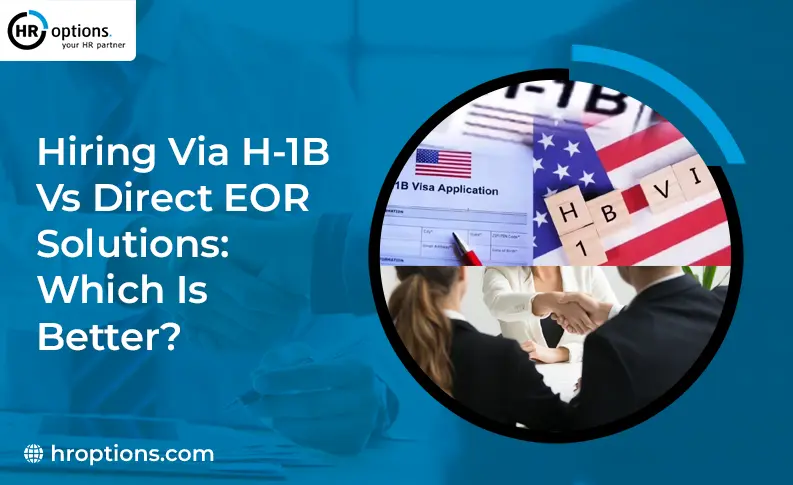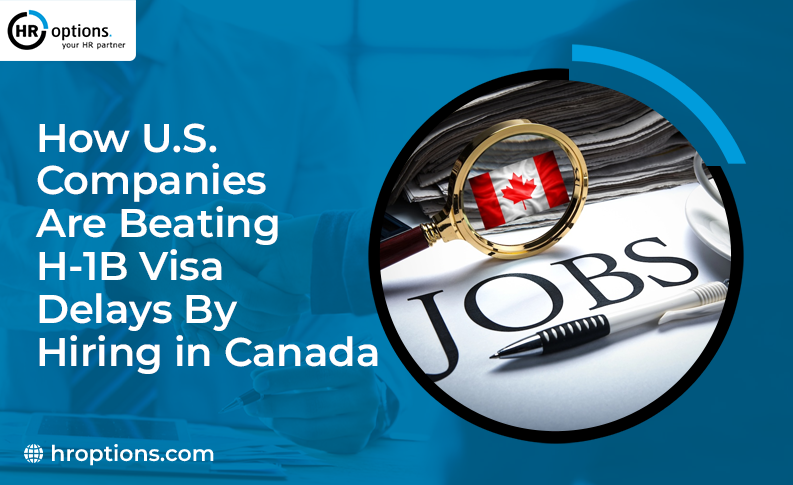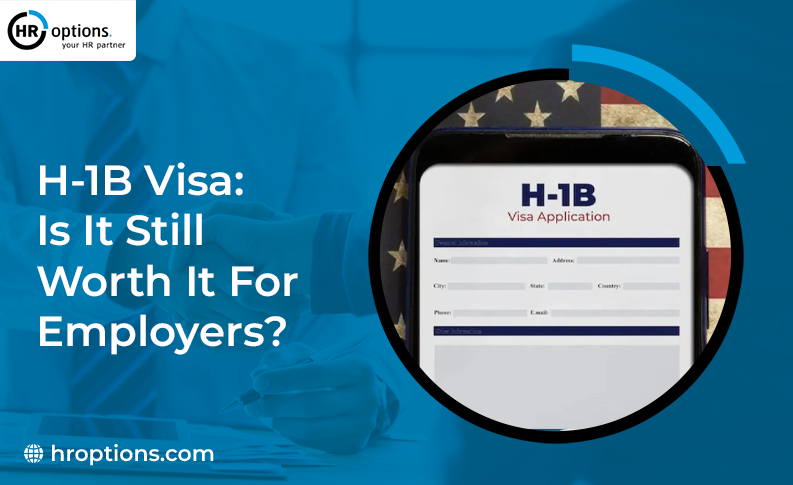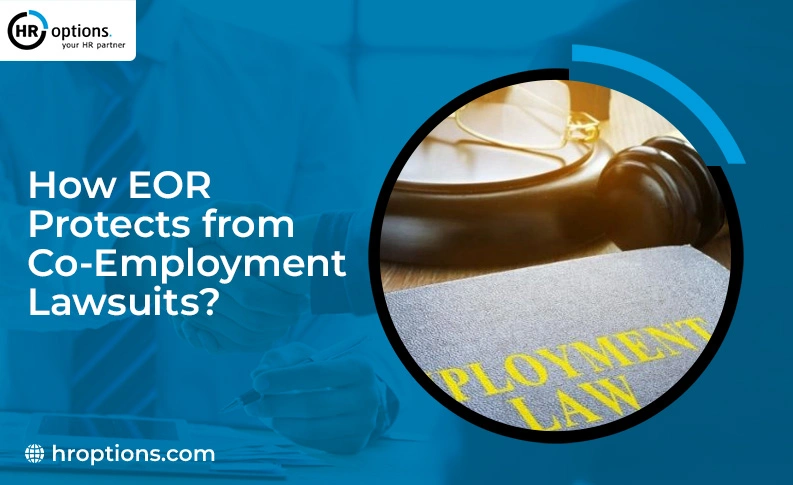Hiring international talent is exciting, but it comes with decisions. Do you sponsor an employee under the H-1B visa and bring them into the U.S., or do you opt for a global hiring model using an Employer of Record (EOR)? Many companies struggle at this crossroads. When speed and global reach are most crucial, hiring through an EOR makes more sense. You avoid the high costs, visa lotteries, and relocation challenges associated with sponsoring an H-1B visa.
With an EOR, you can onboard talent quickly from anywhere and avoid the complexities of immigration. On the other hand, if your role requires an in-person U.S. presence, secure facilities, or long-term U.S. residency, hiring an individual with an H-1B visa could be the right path. But for remote teams or international hires without entity setup, direct EOR solutions offer greater flexibility. In most cases where relocation isn’t essential, the EOR model wins out.
What Is H-1B Sponsorship?
Let’s break down the H-1B route in simple terms.
- Definition and purpose of the H-1B visa: The H-1B visa is a non-immigrant visa category to the United States, designed for U.S. employers hiring foreign professionals in a specialty occupation.
- Key features: U.S. work authorization for foreign “specialty occupation” employees, employer‑sponsorship obligations.
- It is usually necessary to have a certificate, such as a bachelor’s degree or its equivalent, in a specific field, and the employer typically files the petition.
- The H-1B process is complex: There’s a cap (lottery) system, lengthy paperwork, and strong employer obligations. For example, recent changes include a fee for new filings in some cases. Relocation and integration costs add up.
- Situations where an H1B visa is the sole/best course of action include transfers to US headquarters, on-site staff inclusion, and specific policies regarding immigration.
Suppose you need an employee’s physical presence in the U.S. If your operations or clients require on-site collaboration within U.S. facilities, and you are ready for long-term residency planning, an H-1B visa could be a perfect choice.
What is an Employer of Record (EOR) Solution?
Now, let’s understand the benefits of hiring an employer of record (EOR).
- Definition of EOR: An Employer of Record (EOR) is a service provider that legally employs workers on behalf of another company in a specific country. While the company directs and manages the employee’s day-to-day work, the EOR handles all legal and administrative responsibilities, including compliance with local labor laws, payroll, taxes, and benefits.
- How EOR works: The company finds talent globally; EOR onboards and employs them locally; the company retains day-to-day management. You engage a candidate; the EOR handles employment contracts, local compliance, payroll, and benefits. You direct the work.
- Benefits: no need for the hiring company to set up a legal entity in the worker’s country, reduced compliance burden, and faster onboarding.
- This model enables faster access to global talent without the costly formation of entities and the burdens of heavy visa/legal requirements.
- Situations where it is most beneficial for teams to be remote or distributed include global expansion and hiring in markets without an existing local presence.
If you’re building a remote/distributed workforce, testing new markets, or hiring internationally without establishing a local subsidiary, EOR makes sense.
Side-by-Side Comparison: H-1B Sponsorship vs. EOR
Here’s a comparison to help you see where each option stands in key dimensions:
| Criteria | H‑1B Sponsorship | EOR Hiring |
| Scope of hiring/relocation | Focus on bringing workers into the U.S. | A worker stays in their home country or region. |
| Cost (upfront & ongoing) | High legal, filing, relocation costs (recent $100K fee), | EOR service fee plus local compensation and benefits; no visa/relocation cost |
| Time to onboard | Potentially many months (lottery, filings), | Days to weeks after the contract is executed |
| Risk and uncertainty | Lottery risk, visa denial, compliance burden | Lower immigration risk; legal compliance still needed locally |
| Geographical flexibility | Limited to the U.S. location | Global flexibility; location independent |
| Control & cultural integration | Strong on-site control, U.S. cultural alignment | You retain operational control, but geographic/cultural distance may exist. |
When H-1B Hiring Makes Sense?
There are clear scenarios when this solution is the right one.
- When physical presence in the U.S. is mandatory, such as for talent collaboration with a primary client, physical labs, or on-site U.S. client meetings, the move makes sense.
- Employees who require access to U.S.-only facilities, restricted systems, or federal security clearances are best suited for U.S.-based roles.
- When looking at long-term U.S. residency and professional growth. When the goal is for your talent to build a long-term career in the U.S. with an eye on potentially obtaining U.S. residency, the H-1B visa is the way to go.
- Companies with robust immigration/legal departments and high hiring budgets. Because the process is time and cost-intensive, larger firms with experience and budget can absorb the burden more easily.
When EOR Hiring Is the Better Option?
For many companies, an EOR option offers practical benefits. Here’s when it makes sense:
- When the goal is rapid access to global talent, and speed is a priority, hiring through an EOR can help bypass visa delays.
- For fully or partially remote teams. If the employee will be remote and not physically present in the U.S., the EOR model provides flexibility.
- In the case of minimizing visa, relocation, and legal overheads. This eliminates U.S. immigration procedures, enabling you to manage a global workforce more easily.
- For startups and mid-sized companies looking to expand internationally. Smaller firms may not have the budget or legal infrastructure necessary for an H-1 B visa. EOR is an efficient alternative.
- When testing new markets before setting up a legal entity. If you want to pilot hiring in a country without committing to entity formation, an EOR gives you flexibility.
Conclusion
Choosing between H-1B and a direct EOR solution is not about one being universally better than the other. It’s about finding a balance between your hiring needs, budget, risk tolerance, and growth plan. If you require the physical presence of someone in the U.S. and are willing to pay the associated costs and time, an H-1B visa may be a suitable choice.
However, if you are looking for agility, global reach, and faster execution of activities, the EOR option may be a better fit for you. Ultimately, the key is to have a clear hiring strategy and select a model that aligns with the structure of your team and its objectives. When you go the right way, the hiring process doesn’t get in the way. Contact HR Options to help companies hire globally through compliant, cost-effective EOR solutions.








